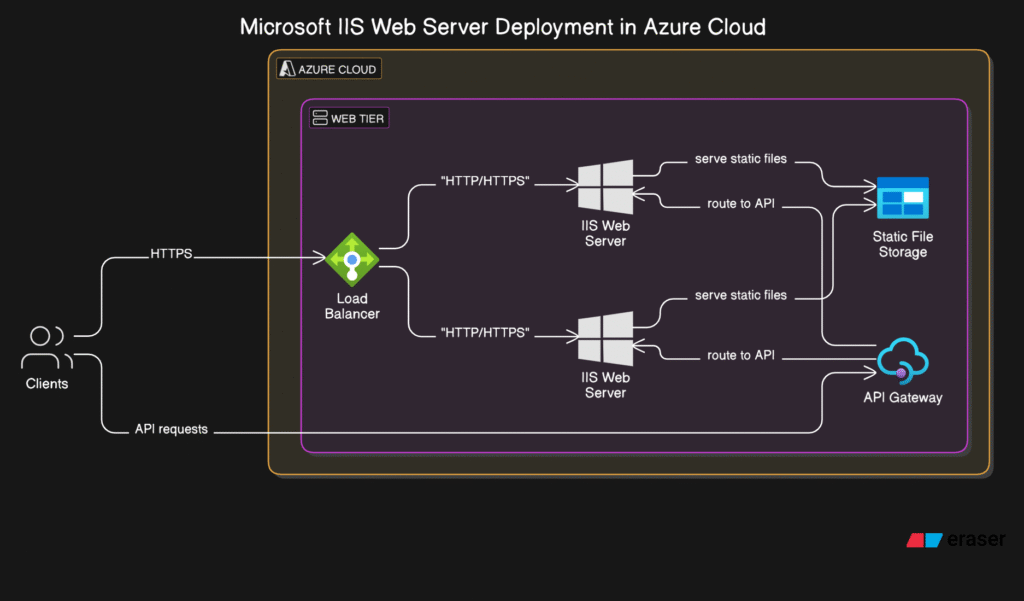📌 Introduction
A Web Server is a crucial component in scalable systems, enabling communication between users and
backend services through HTTP/HTTPS protocols. It helps ensure fast, reliable delivery of web content to clients,
enhancing scalability, efficiency, and user experience. This guide will cover everything you need to know about Web
Servers, from their basics to real-world use cases.
⚙️ What is a Web Server?
A Web Server is a software or hardware system that serves web content (like HTML pages, images, or
APIs) to clients (usually web browsers) over the internet. It listens to client requests, processes them, and sends
back the appropriate response. Essentially, it acts as the bridge between users and your website/application
content.
🧩 Key Benefits
- Scalability: Handles multiple client requests simultaneously and can be horizontally scaled
using load balancers. - Reliability: Provides consistent uptime and health monitoring to ensure applications are always
reachable. - Efficiency: Optimized to serve static and dynamic content quickly with caching, compression,
and concurrency mechanisms. - Security: Supports HTTPS, authentication, IP filtering, and protection against DDoS and other
attacks.
🔧 Types of Web Servers
- Static Web Server: Serves only static files like HTML, CSS, images, etc., without server-side
processing. - Dynamic Web Server: Integrates with applications (e.g., PHP, Python, Node.js) to serve content
generated on the fly. - Reverse Proxy Server: Sits in front of application servers and routes requests, provides
caching, and improves performance.
📊 Architecture

🔁 Use Cases
- Real-Time Systems: Delivering real-time data updates with WebSockets or Server-Sent Events.
- Microservices: Hosting individual microservices accessible via HTTP APIs.
- Edge Cases: Serving content close to users using edge locations or CDNs.
- Hosting APIs: REST or GraphQL APIs served securely and efficiently.
⚙️ Tools & Services
- Open-Source Tools:
- Apache HTTP Server: Widely-used, modular, and flexible web server.
- Nginx: Lightweight, high-performance server often used as a reverse proxy or load
balancer.
- Cloud-Native Solutions:
- AWS EC2 with Nginx/Apache: Deploy your web server on scalable cloud infrastructure.
- Google Cloud Run: Run containerized applications with HTTP endpoints.
✅ Best Practices
- Enable HTTPS: Secure all communications with TLS certificates.
- Use Gzip Compression: Reduce file sizes and improve load times.
- Implement Caching: Use cache headers and reverse proxies for faster content delivery.
- Configure Rate Limiting: Prevent abuse and DDoS attacks.
🔐 Security Implications
- DDoS Attacks: Protect web servers using WAFs, rate limiting, and auto-scaling.
- Misconfigurations: Harden your server by disabling directory listing, keeping software up to
date, and enforcing access control.
📚 Real-World Examples
- Netflix: Uses Nginx to manage high traffic and serve media content.
- GitHub: Hosts Git and web content using reverse proxies and optimized web servers.
- Wikipedia: Uses Varnish and Apache to serve billions of page views efficiently.
🚀 Conclusion
Web Servers are foundational to web applications and digital products. Understanding how they work, how to secure
them, and how to scale them is critical for every backend or full-stack engineer. Whether serving static websites or
dynamic microservices, web servers remain the gatekeepers of modern web traffic.
3 FAQs About Web Server
- What is the primary function of a Web Server?
A web server listens for client requests
(usually via HTTP/HTTPS) and responds with the requested content, such as HTML, images, or data. - How does a Web Server improve system performance?
By caching static assets, compressing
responses, and handling concurrent requests efficiently, web servers speed up the delivery of web content. - What are some common pitfalls when using Web Servers?
Poor configuration, lack of SSL,
absence of caching, and exposing sensitive paths or admin portals are common issues to avoid.

